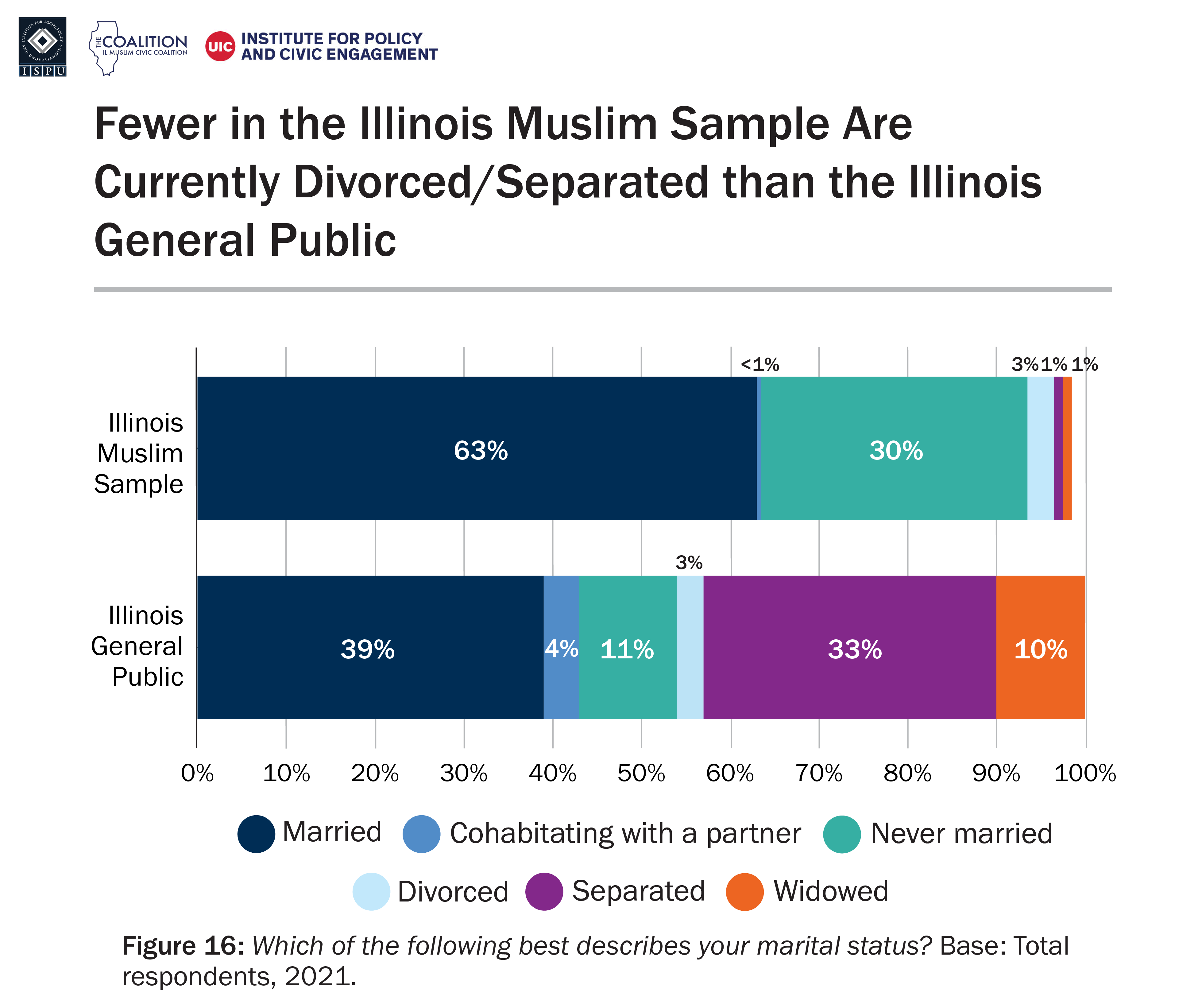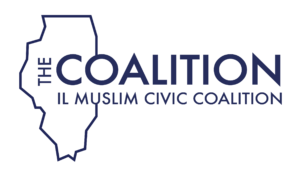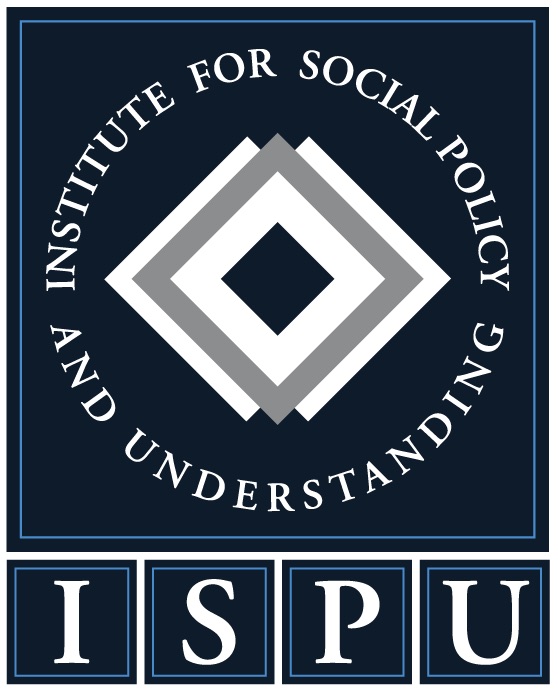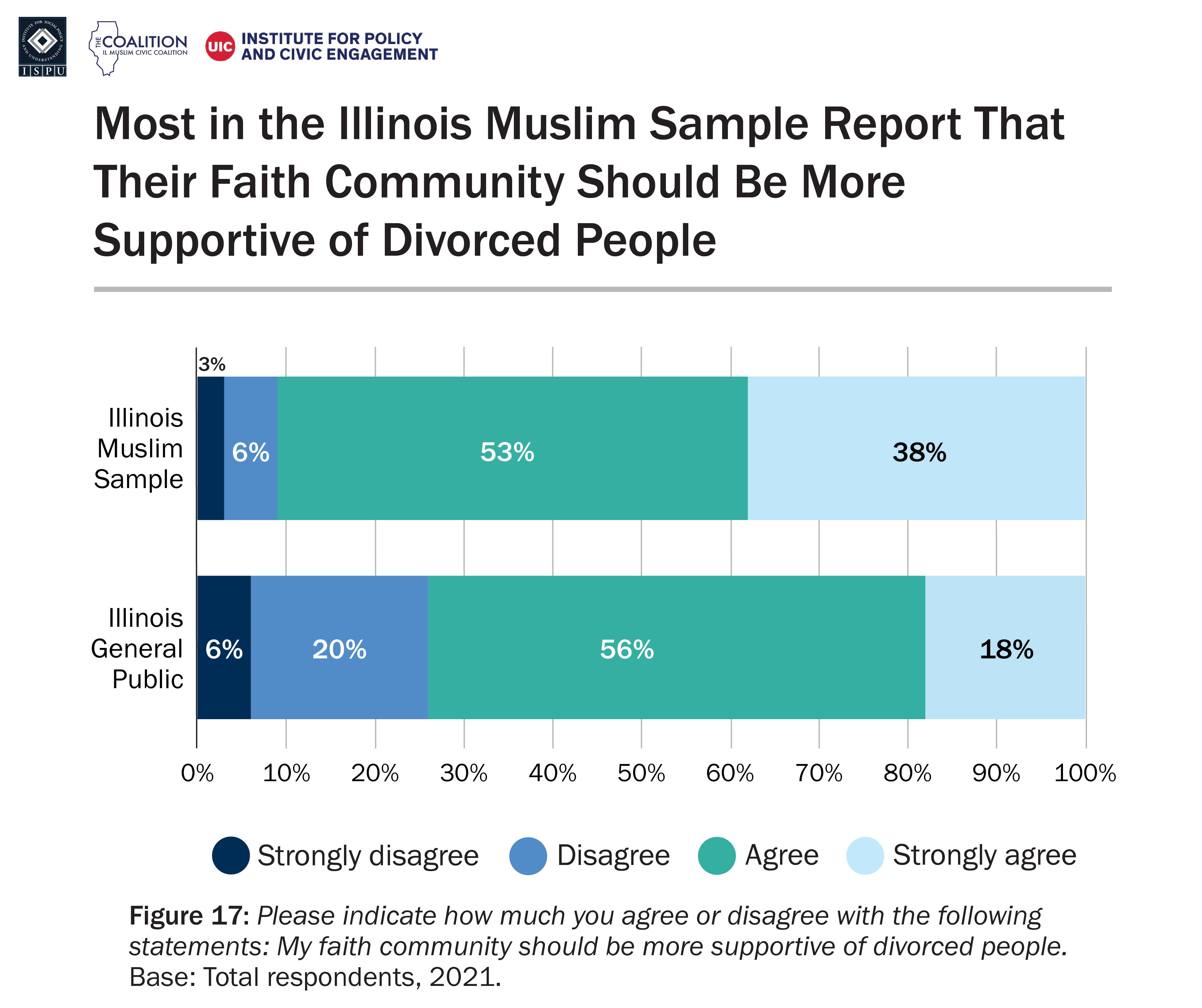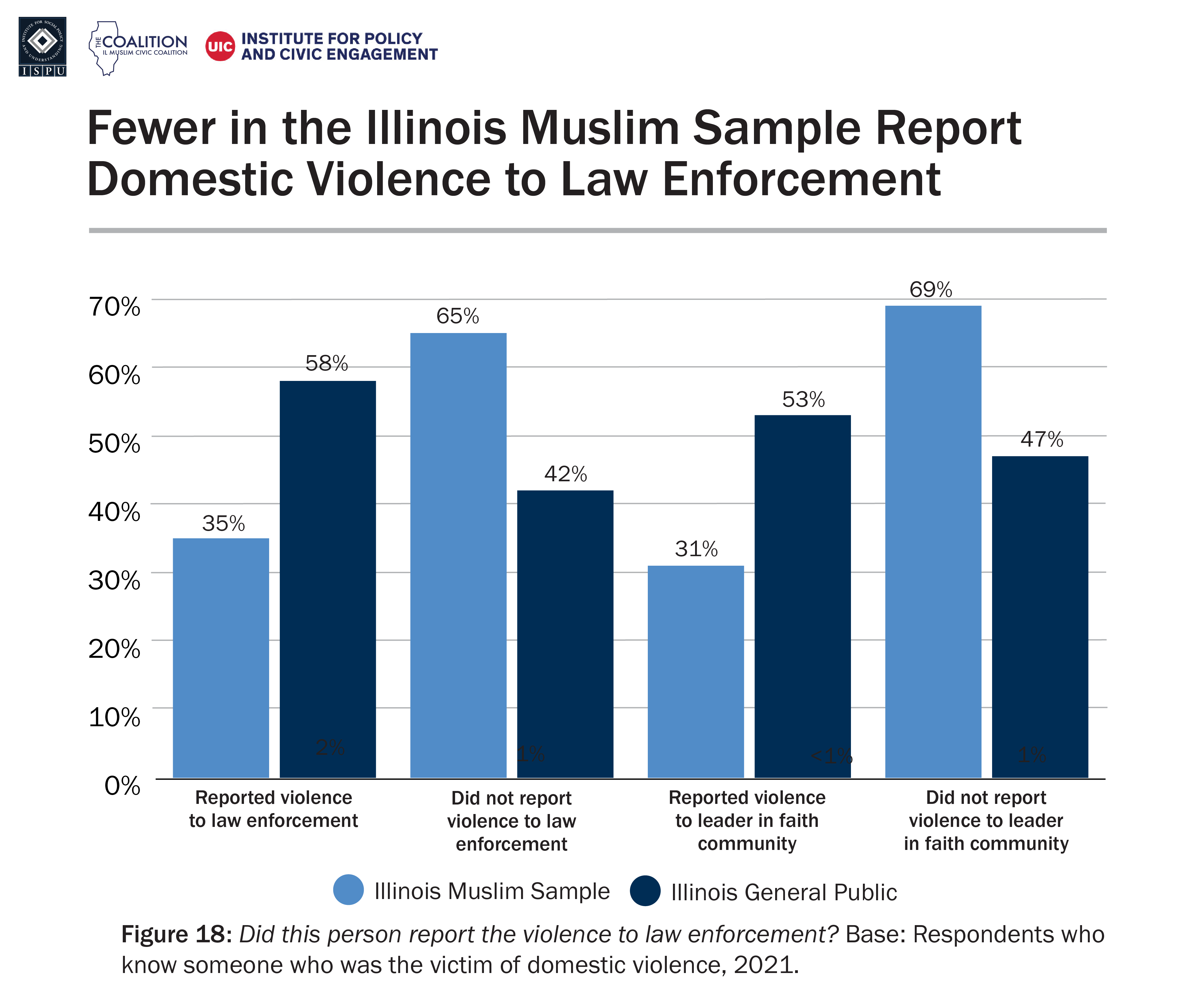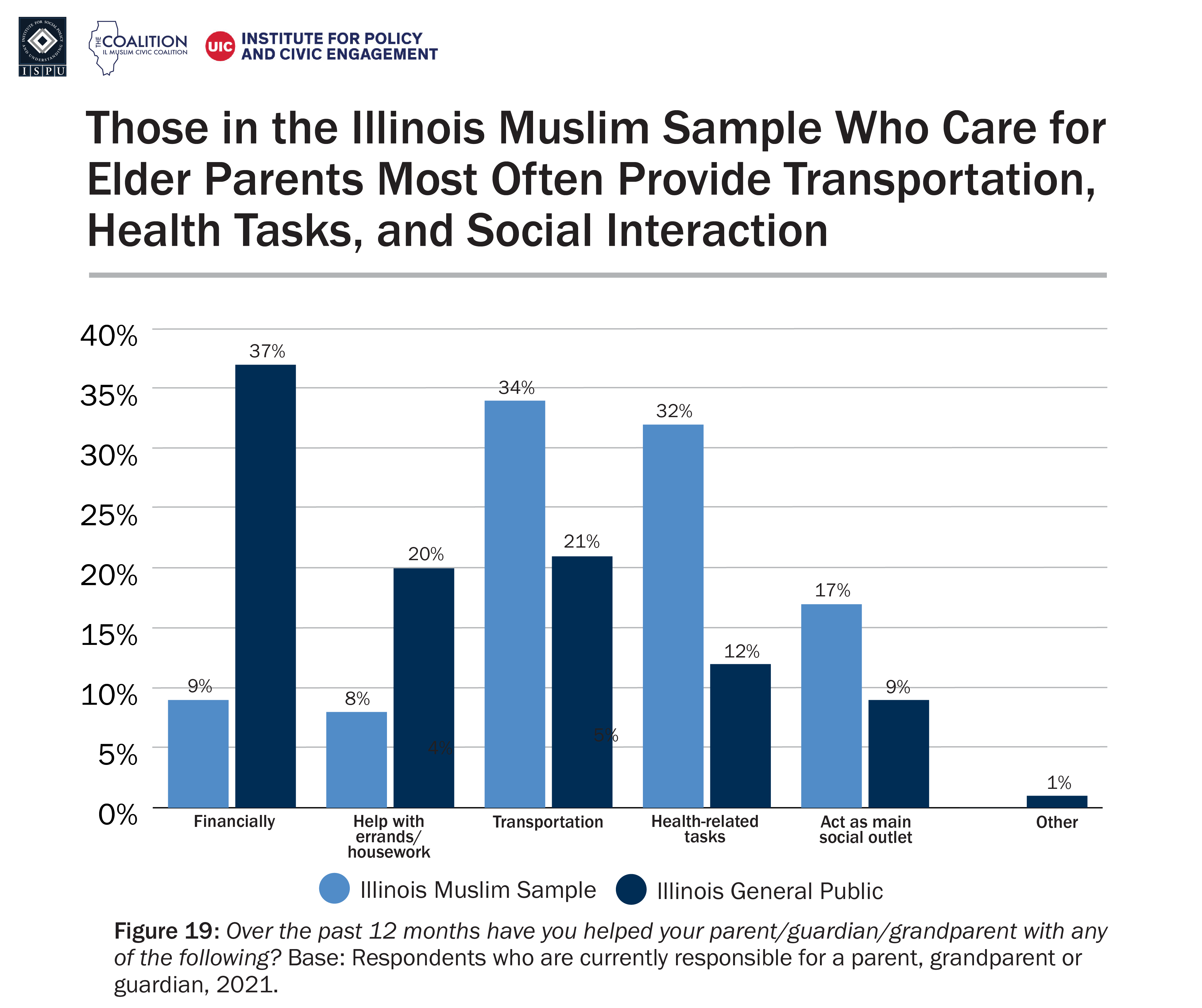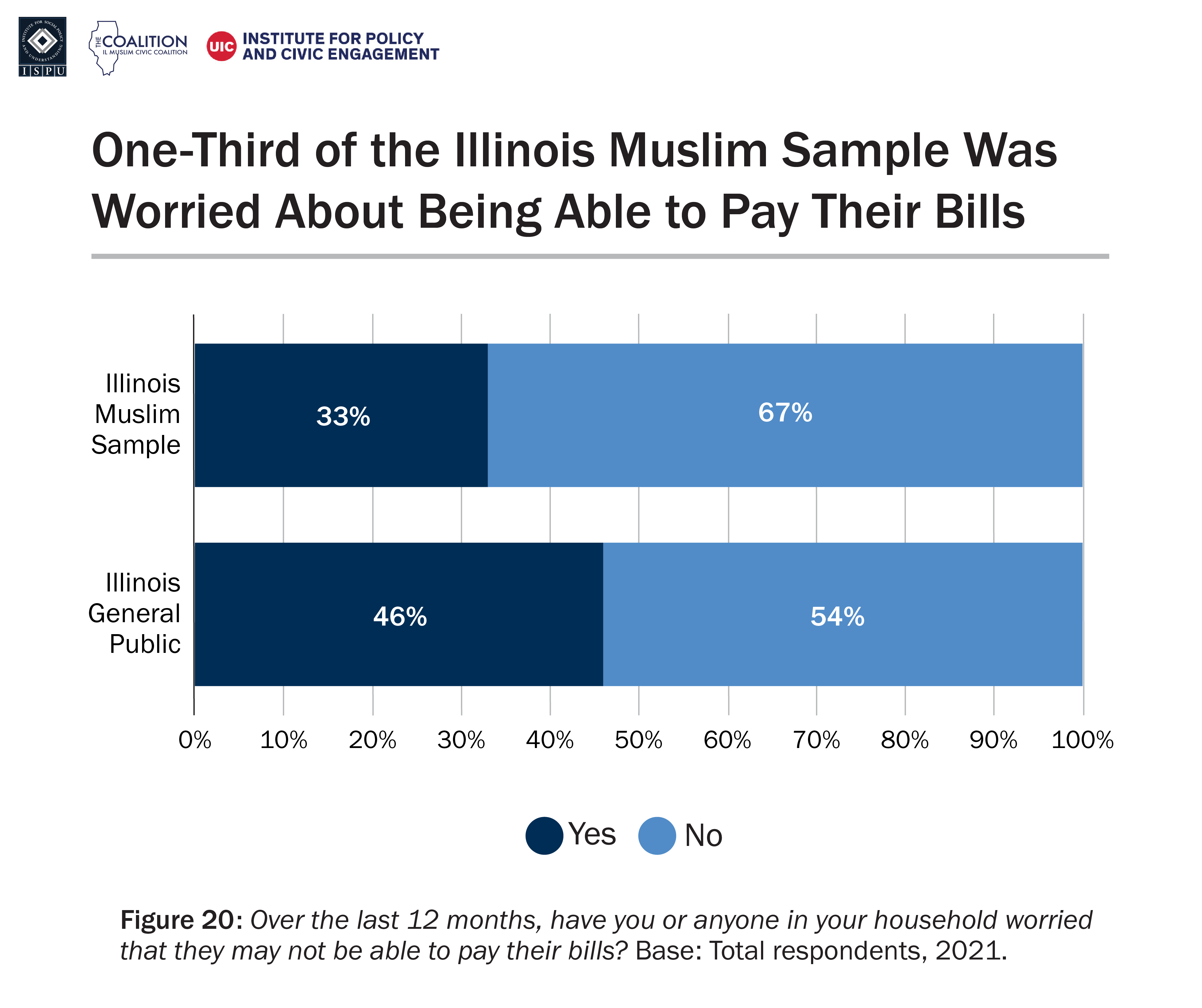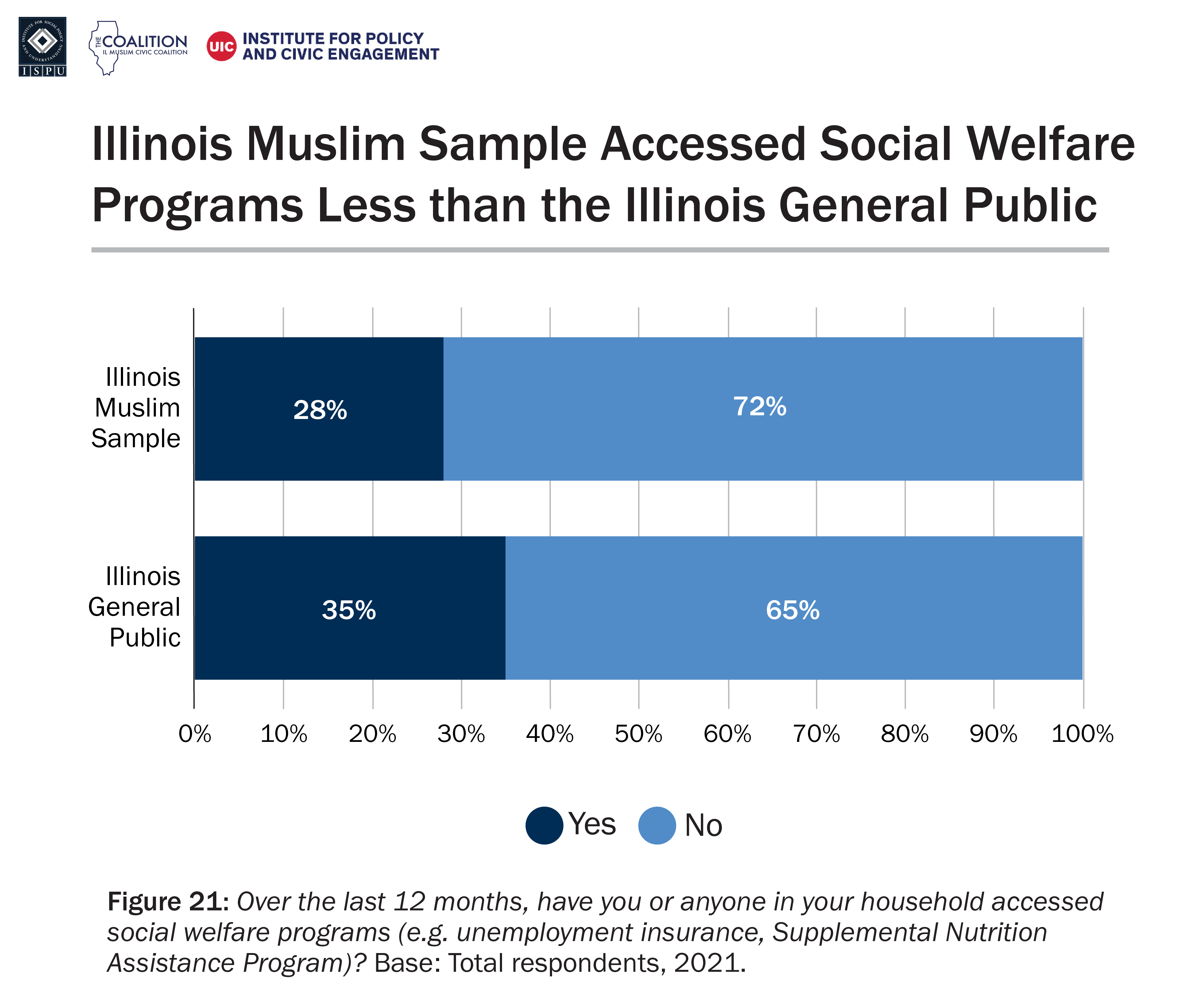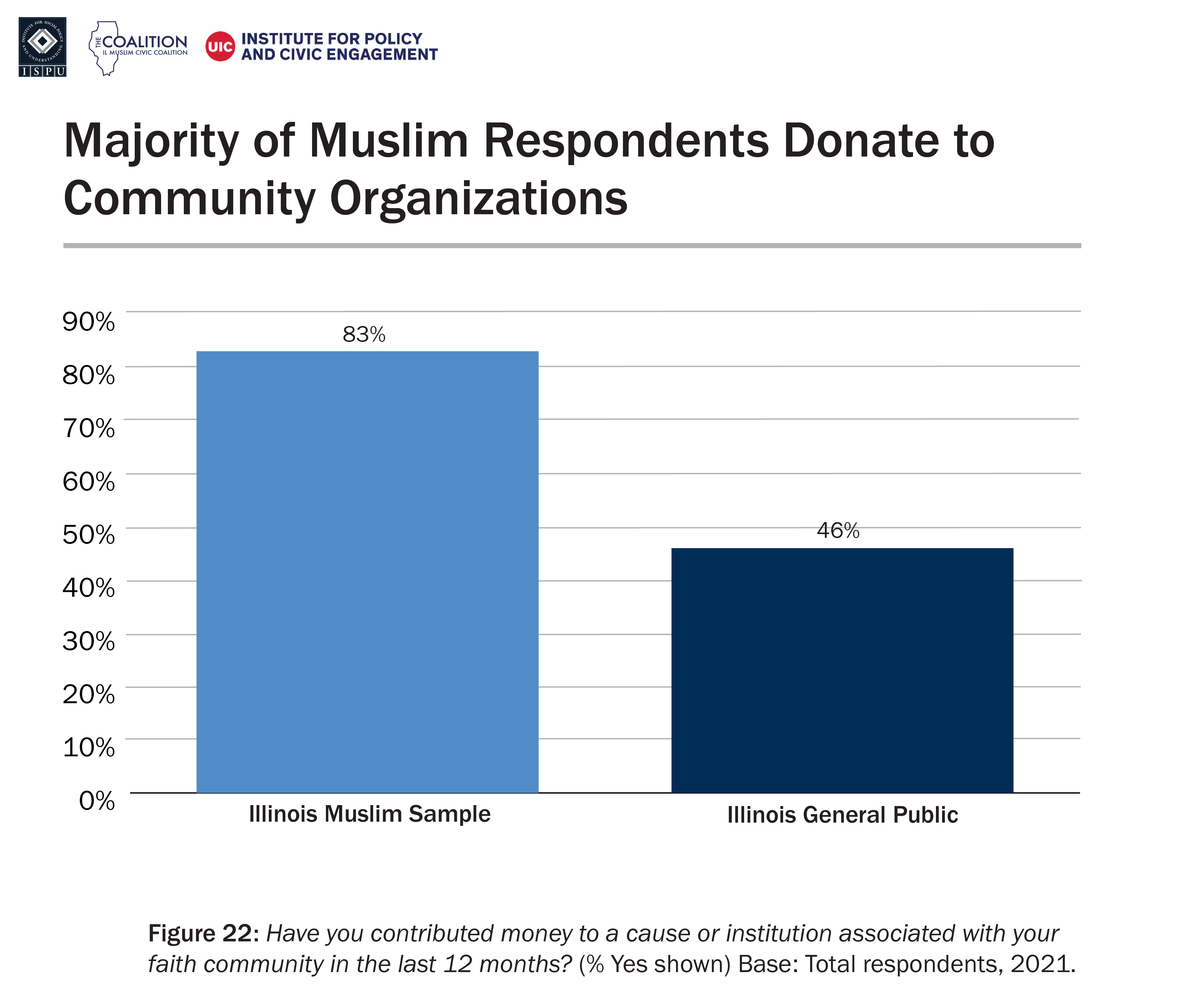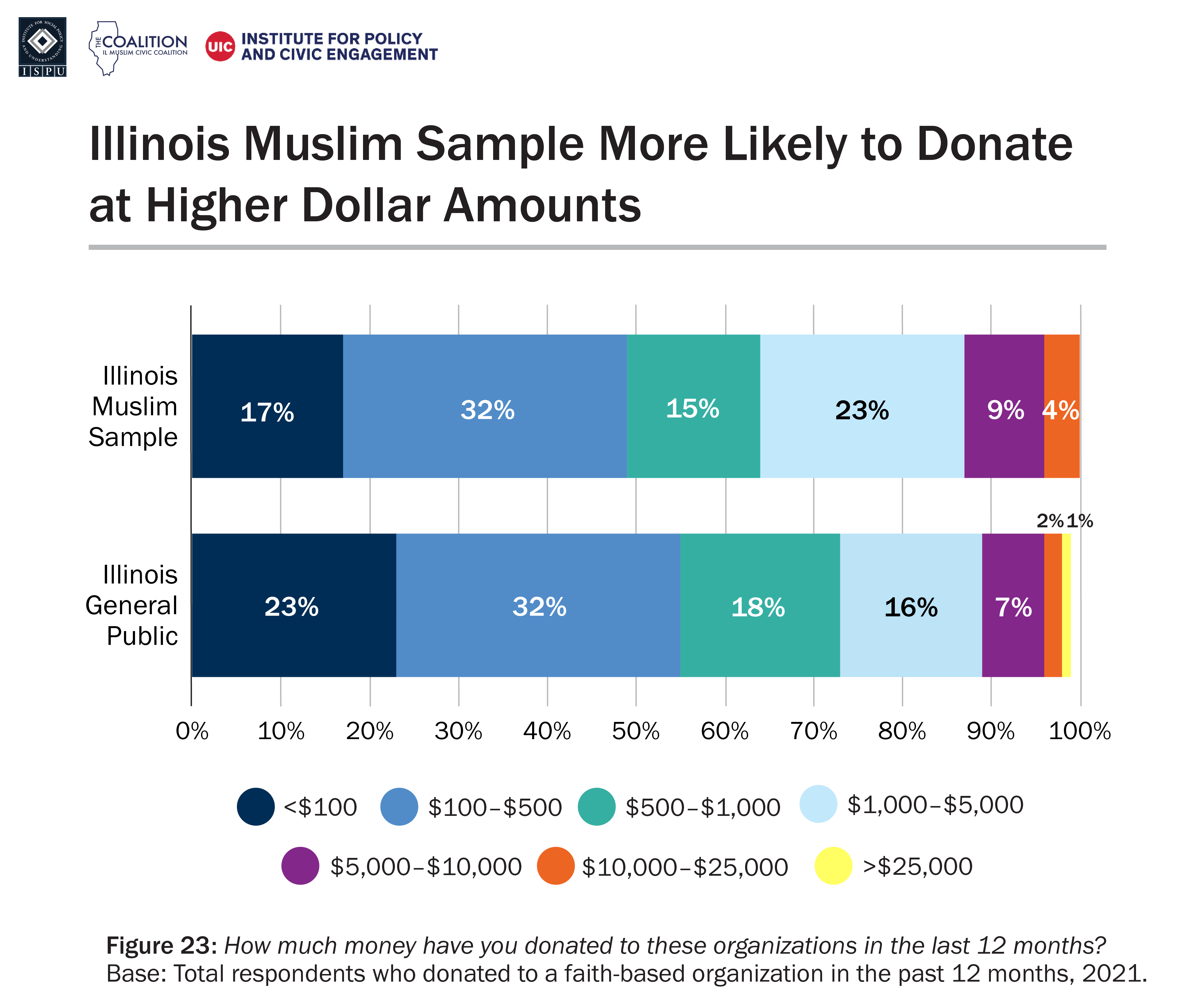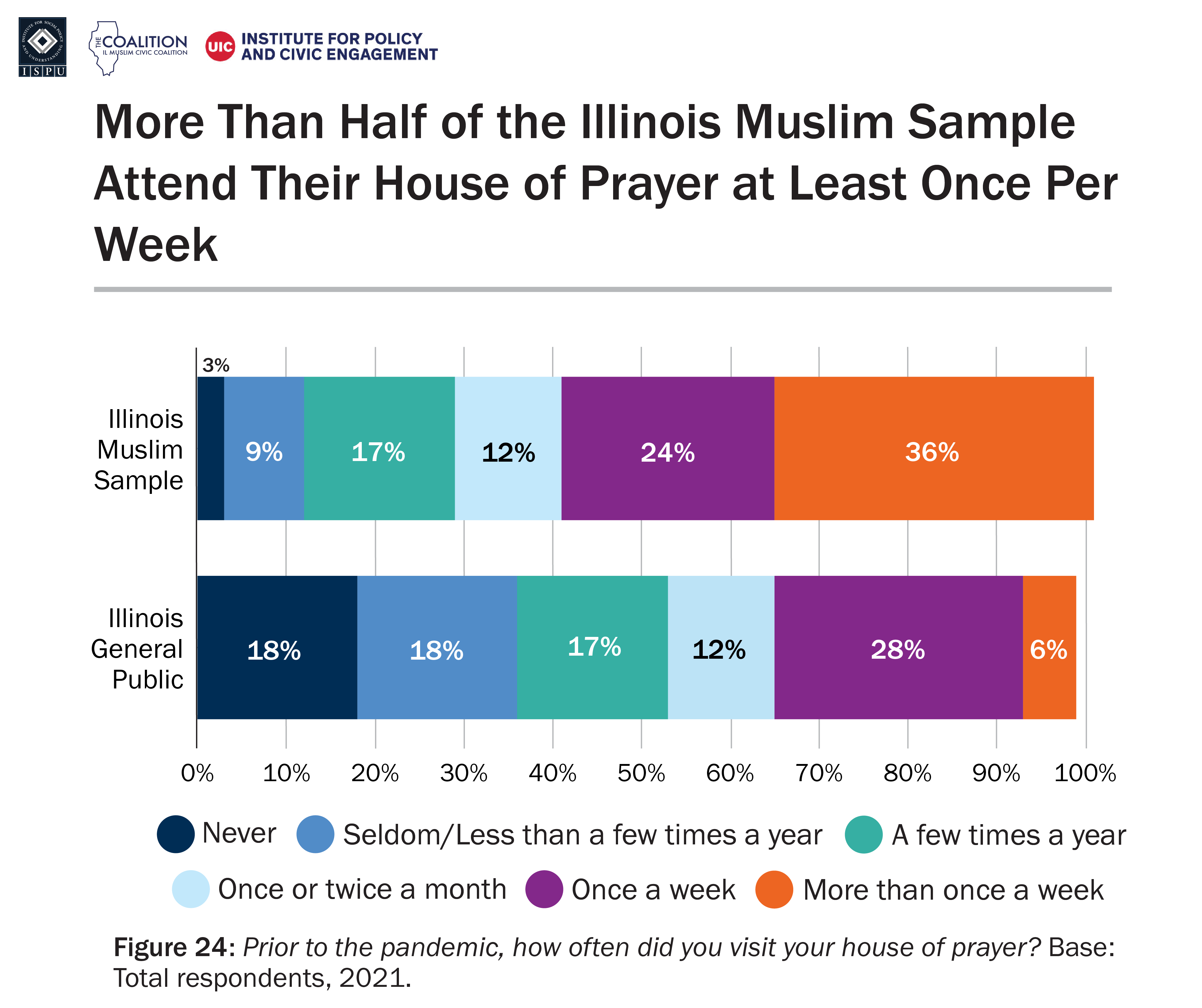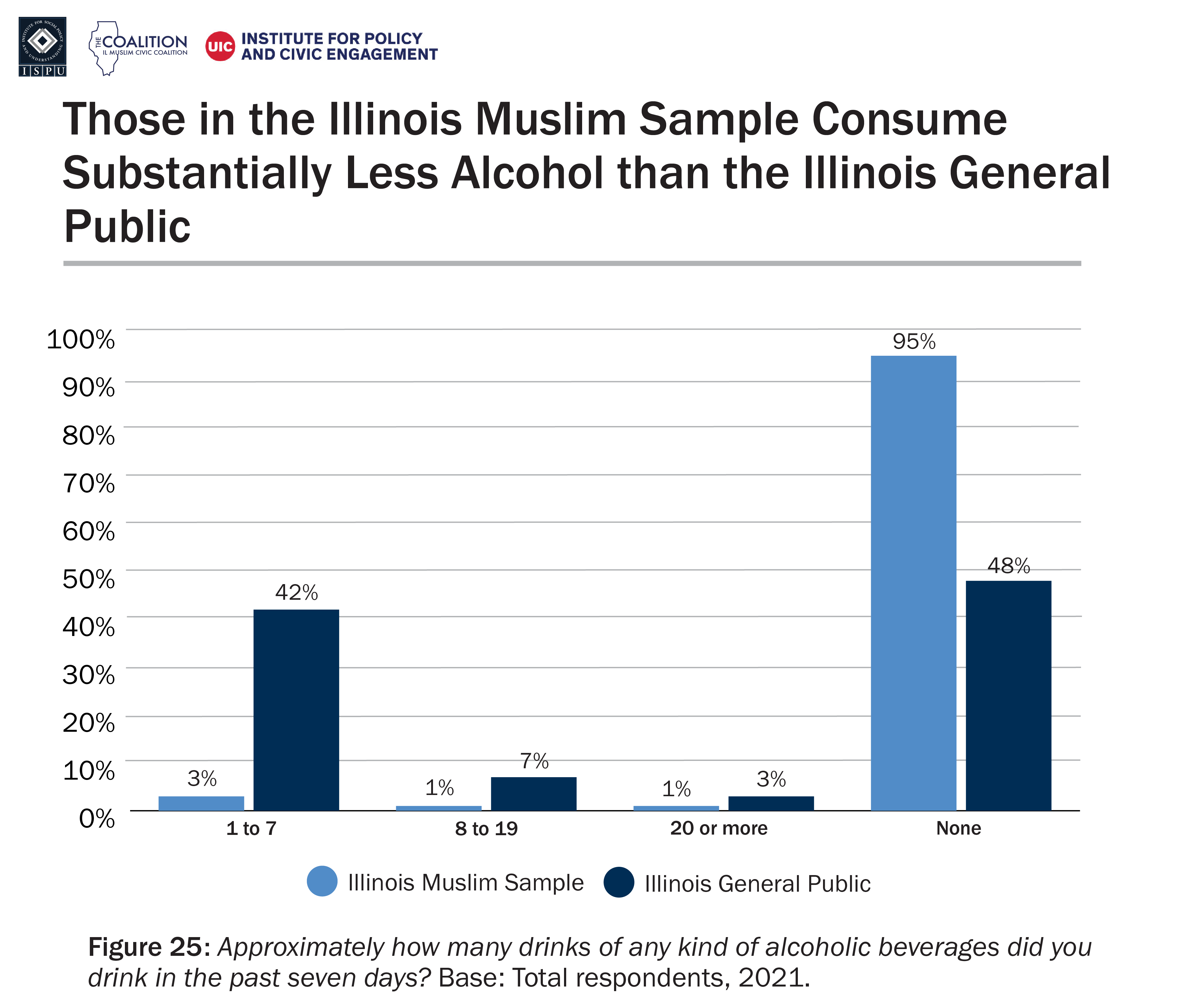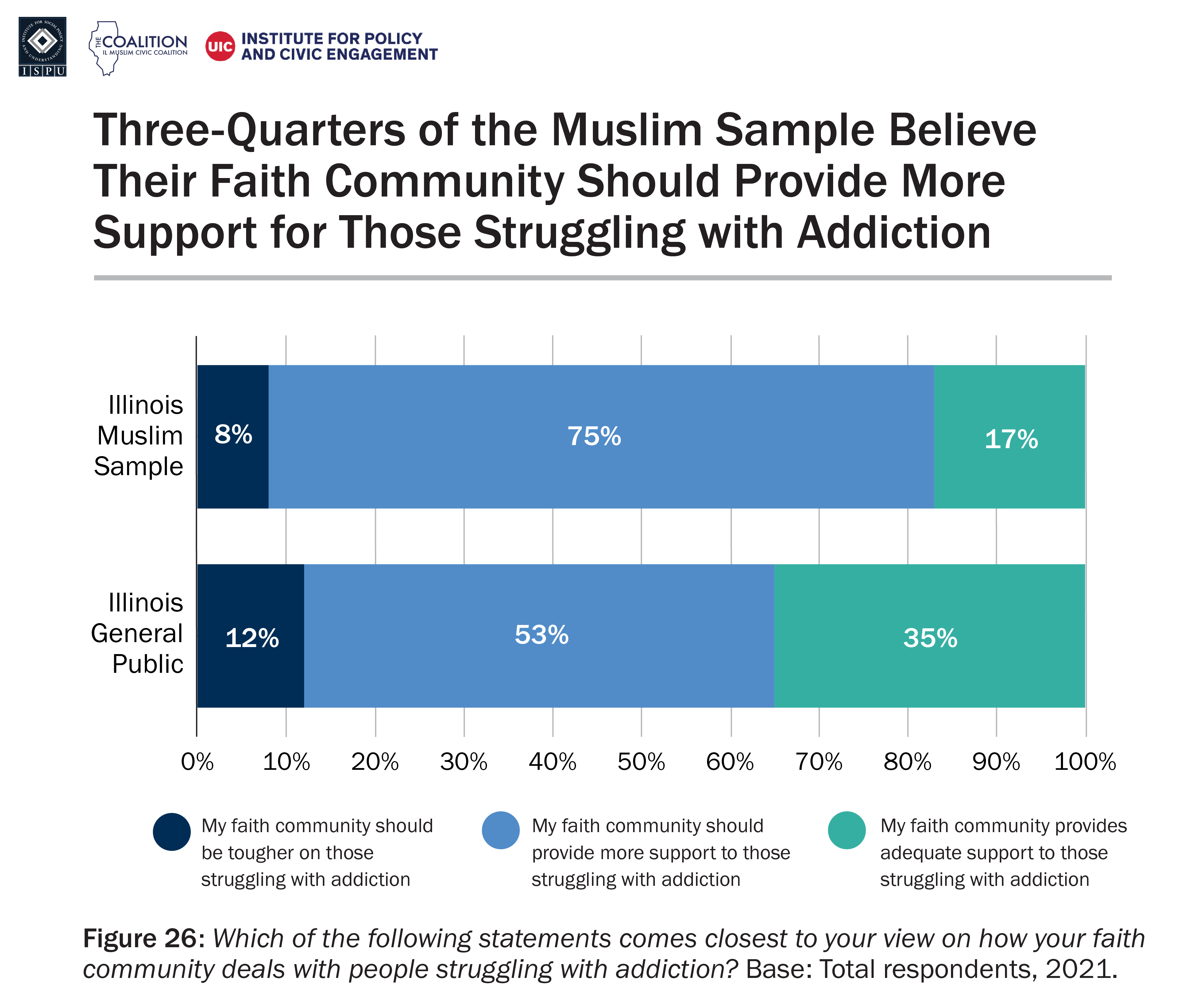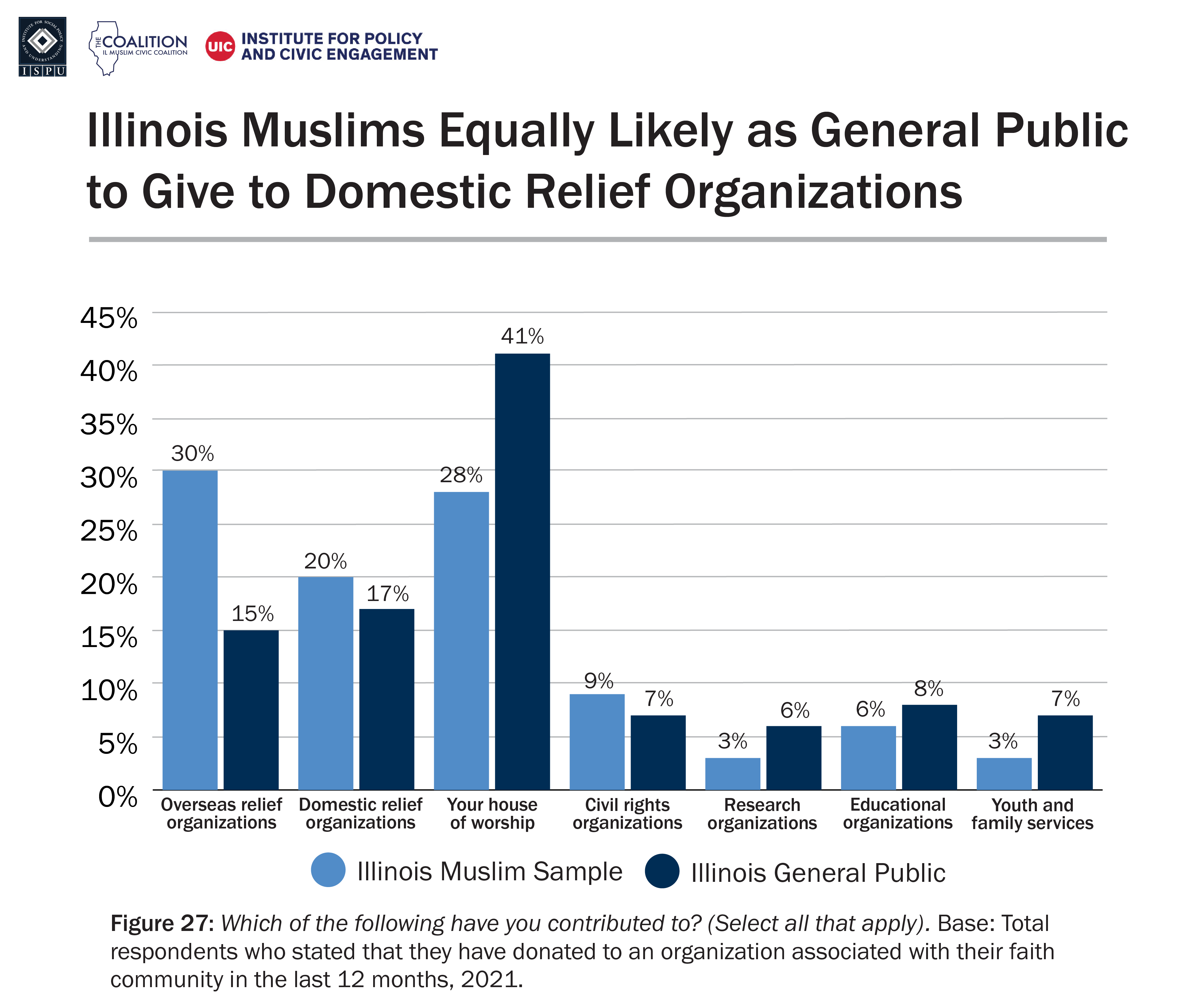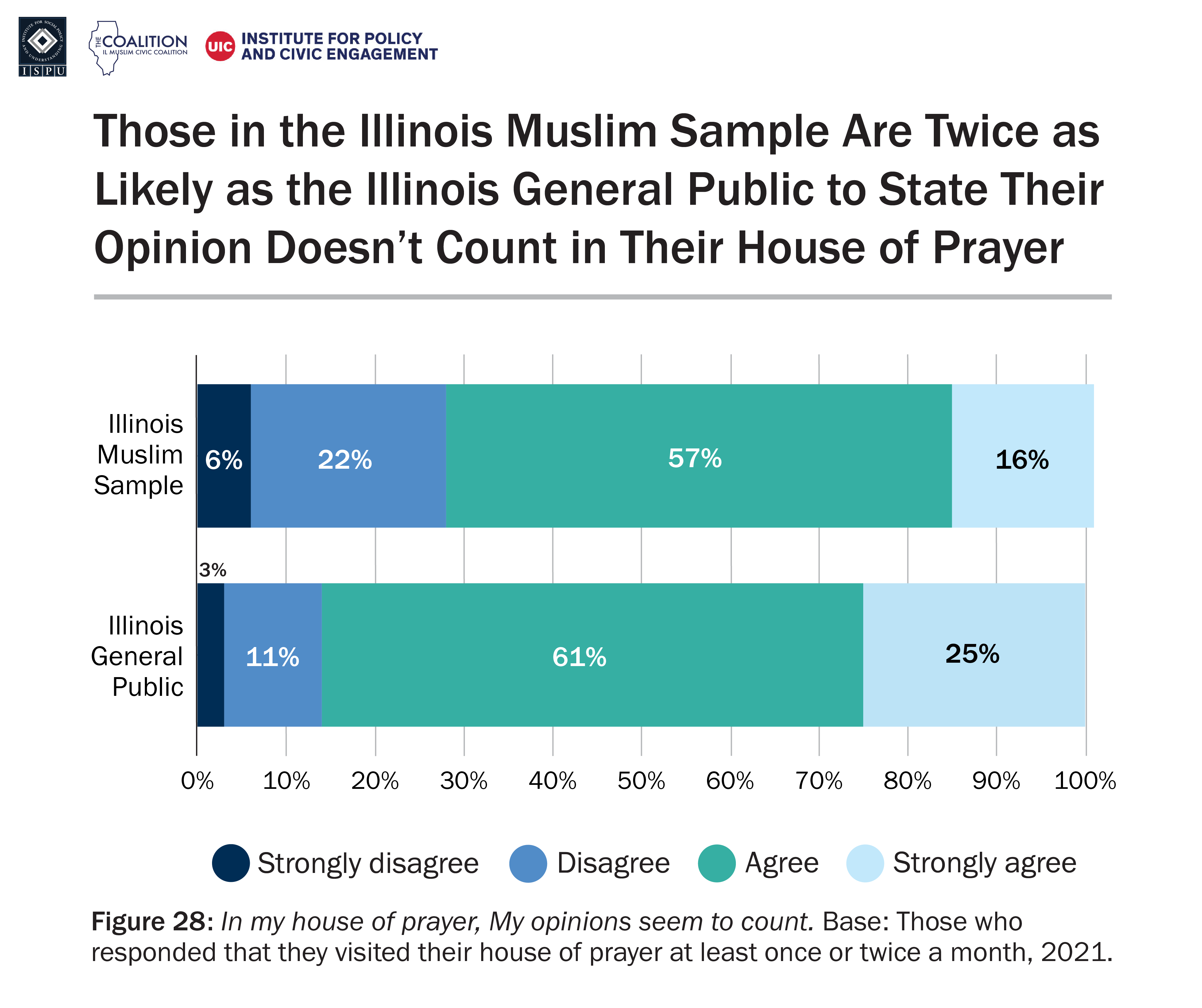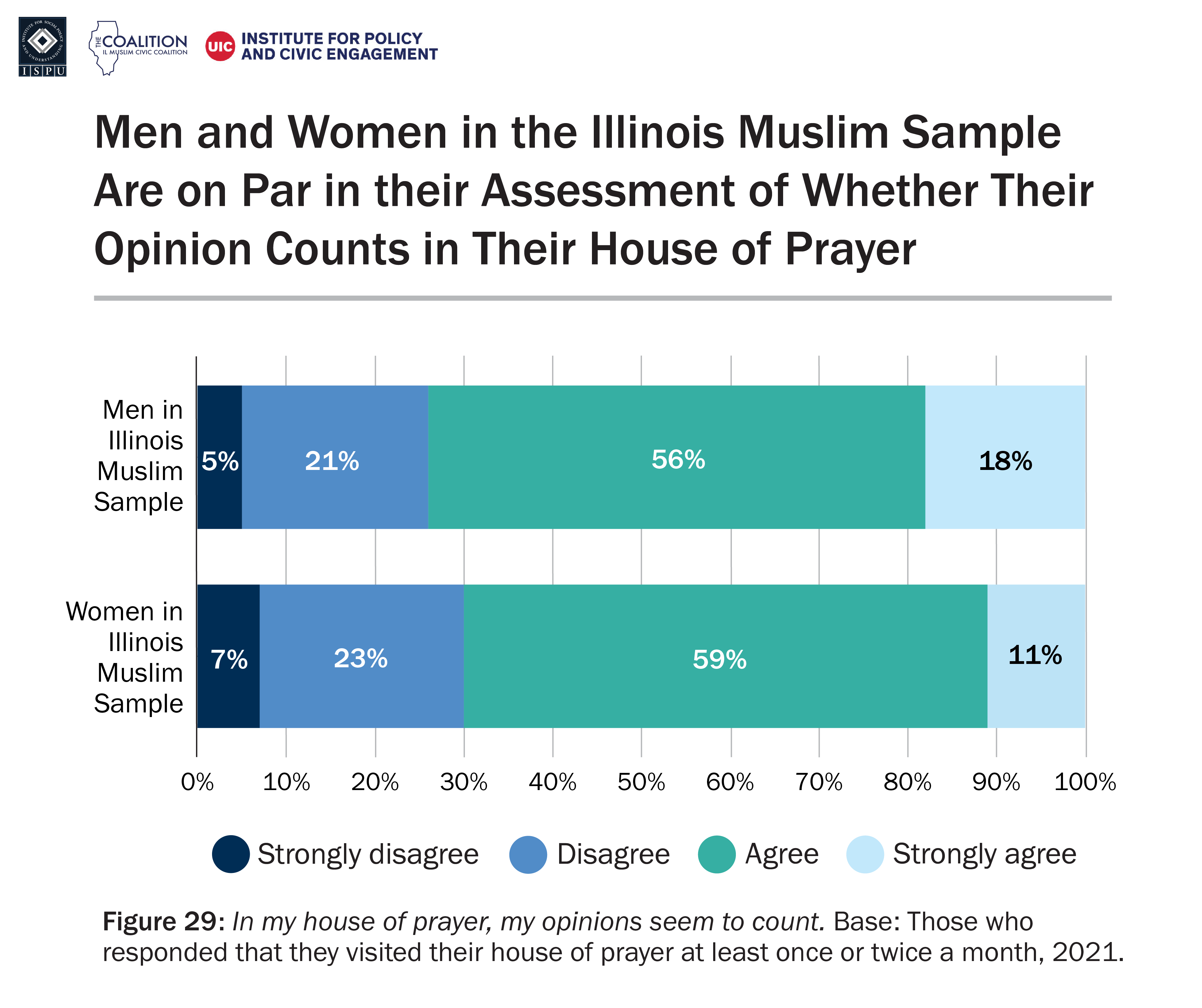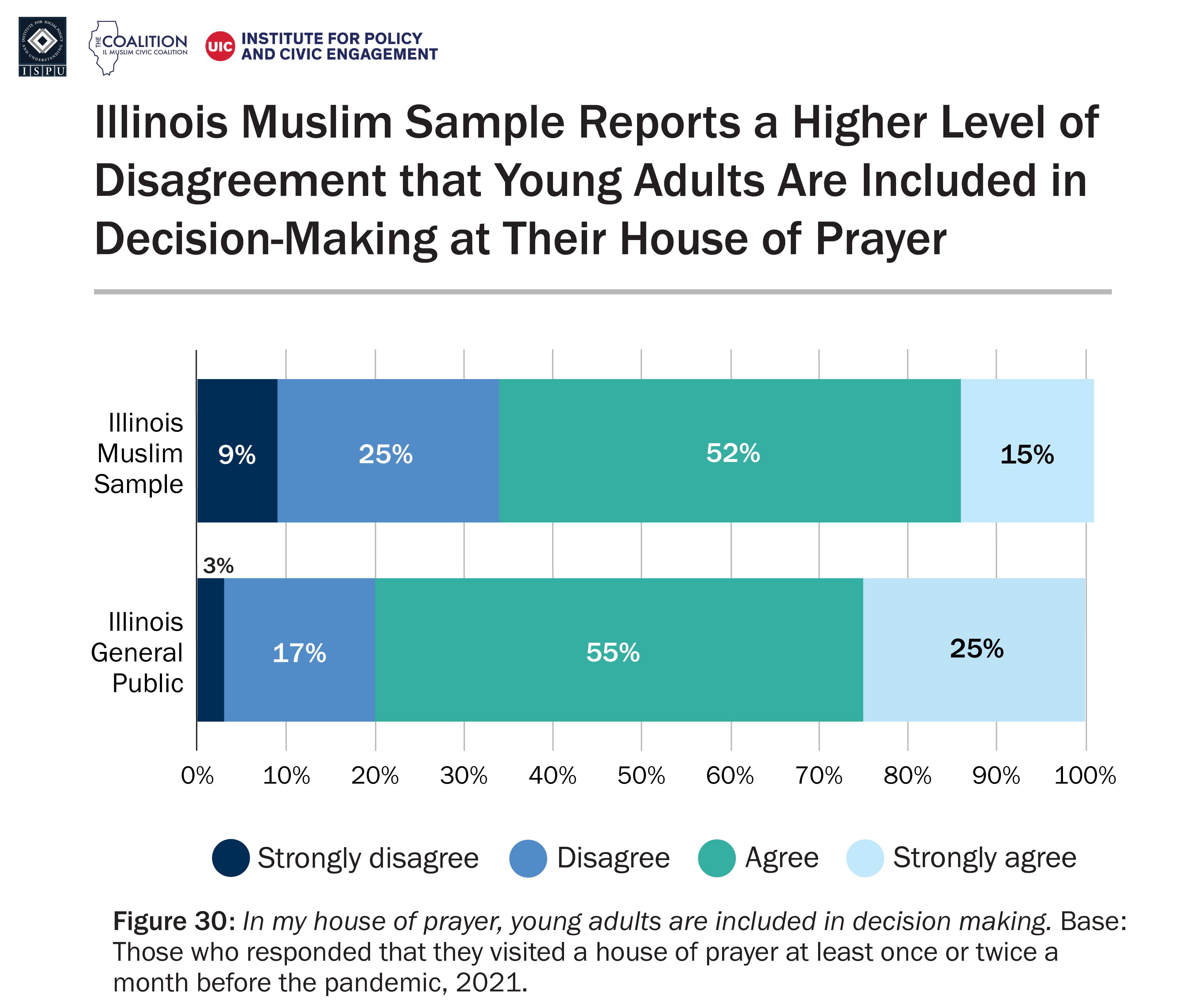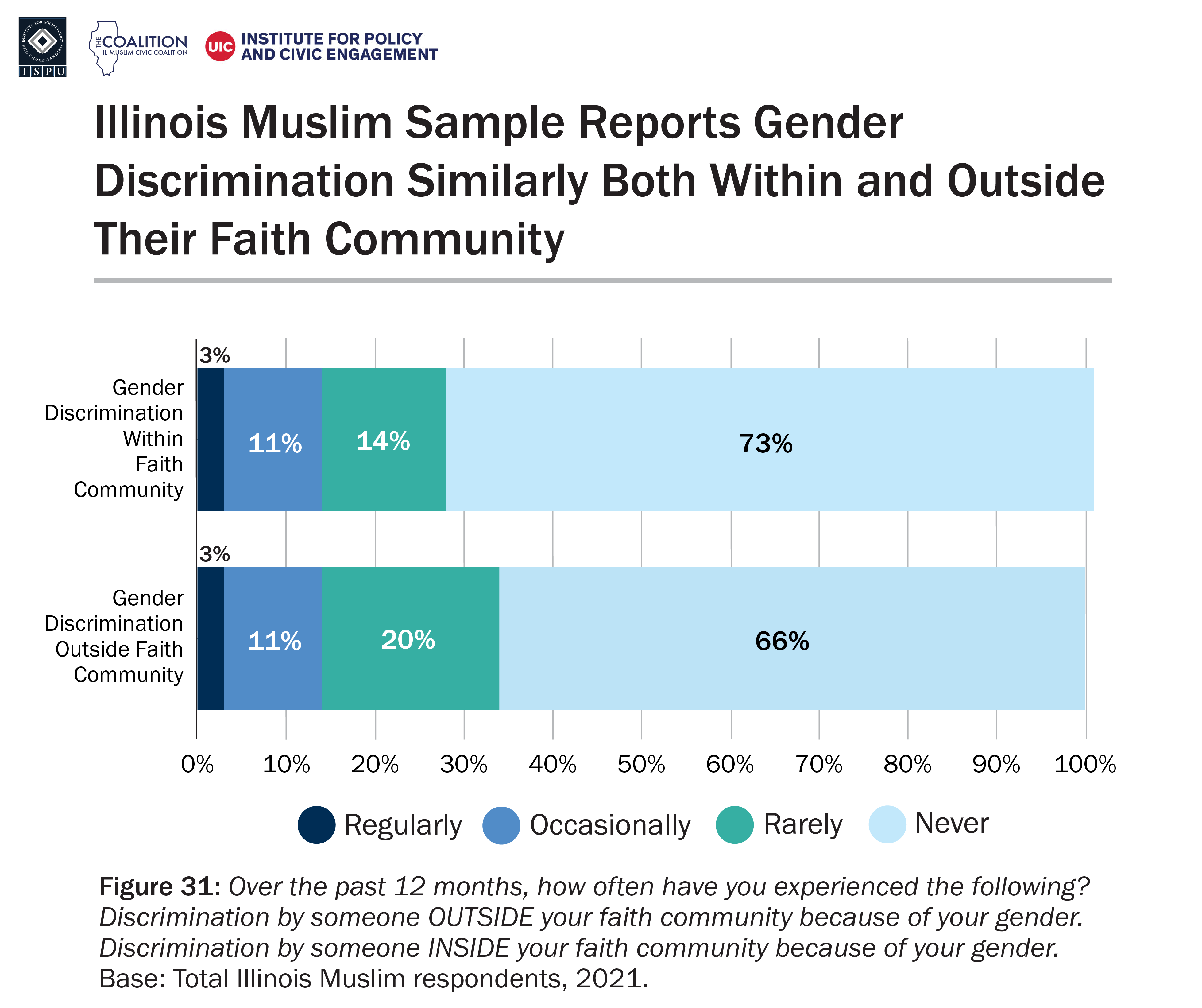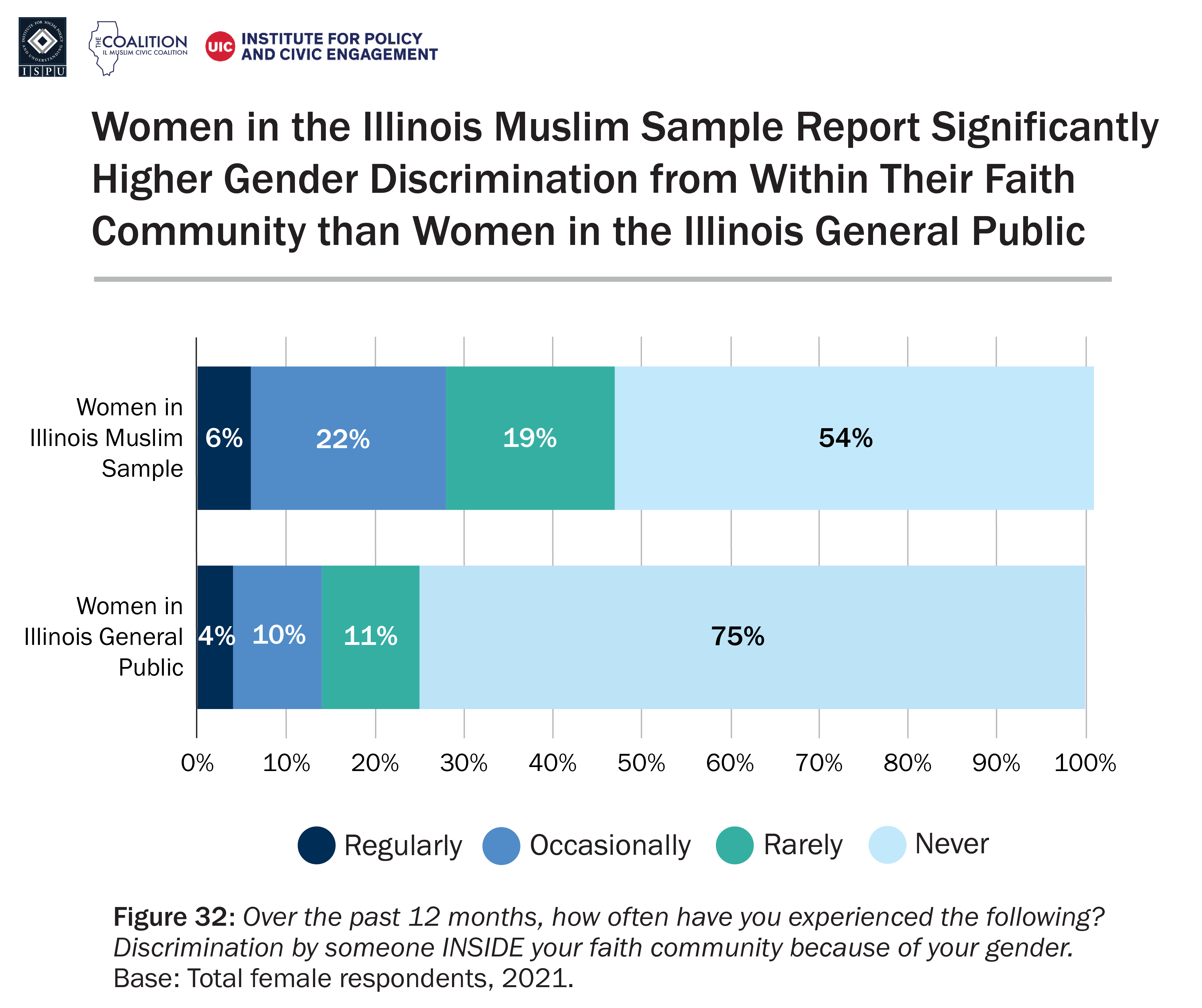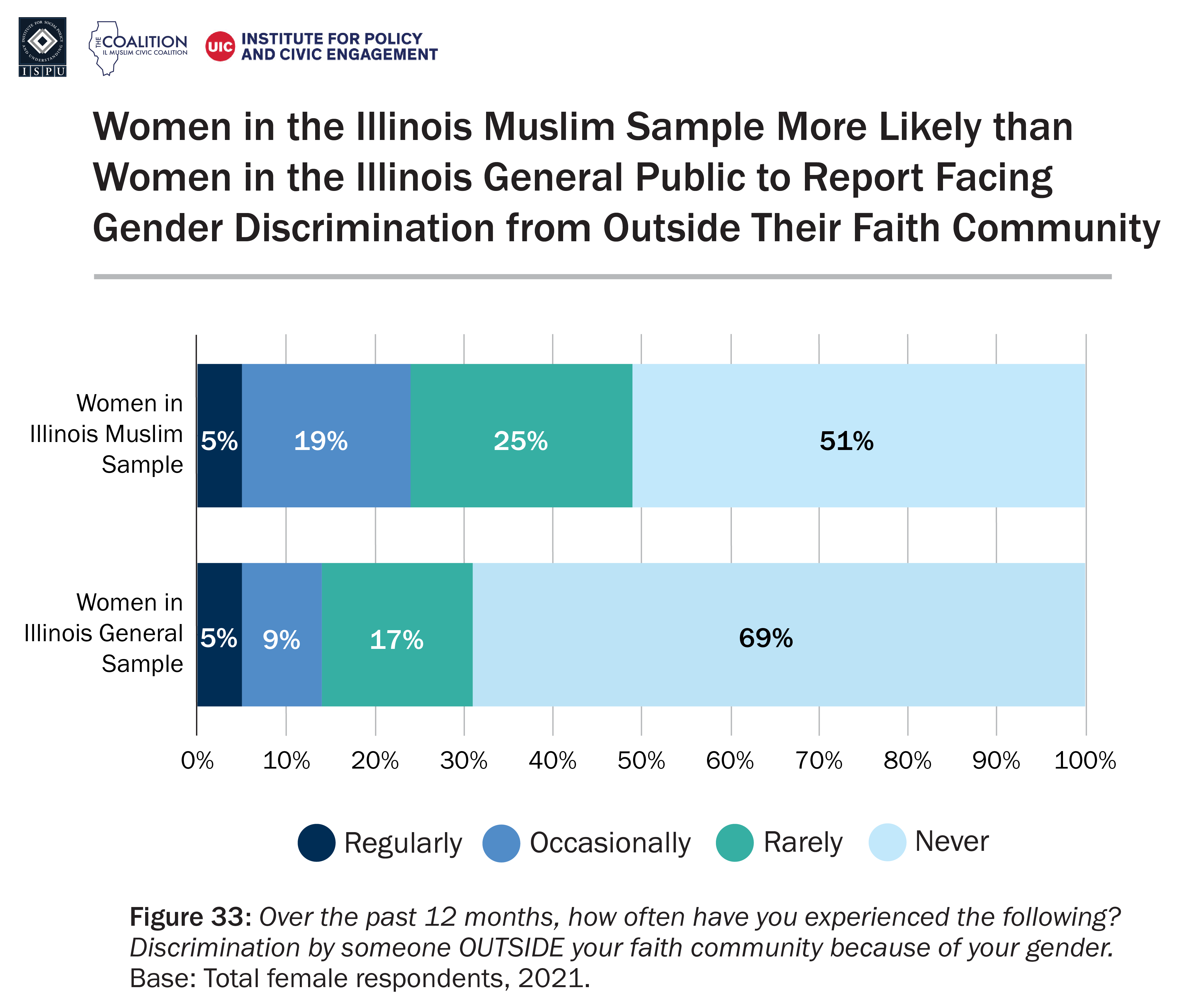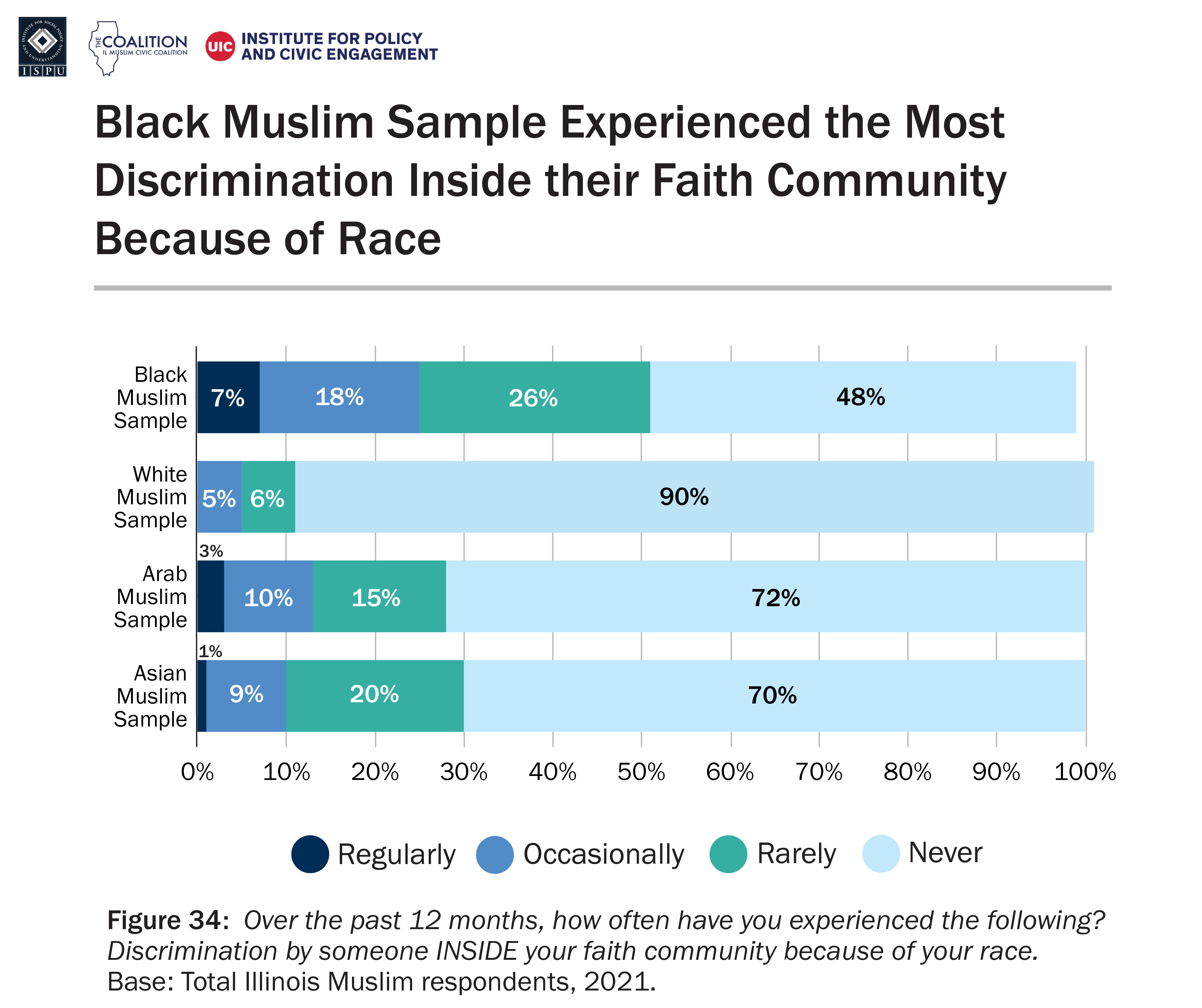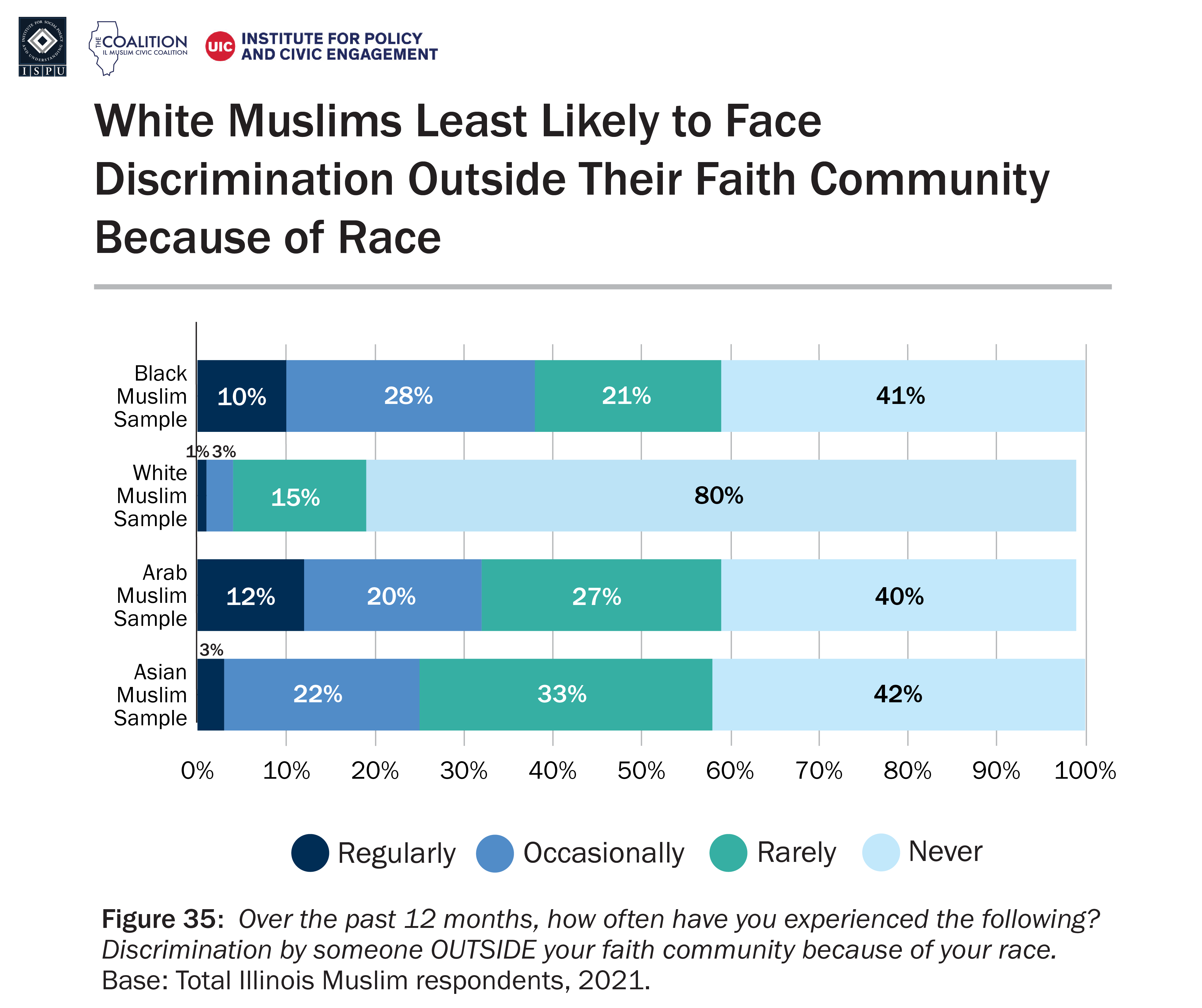.
Illinois Muslims
Needs, Assets, and Opportunities
JULY 28, 2022 | BY DALIA MOGAHED, DR. JOSEPH HOERETH, OJUS KHANOLKAR, AND UMAIR TARBHAI

Results: Family
The survey included questions about the needs and assets of the family and the household unit. Questions pertaining to family touched on topics such as marriage and divorce, care for extended family, access to jobs, and household expenses.
ASSET: Muslim Marriage
DOWNLOADS
TABLE OF CONTENTS:
Page 1: Executive Summary, Report Overview
Page 2: Introduction, Results: Demographics
Page 3: Results: Individual
Page 4: Results: Family, Results: Community
Page 5: Results: Broader Society, Recommendations and Opportunities

DOWNLOADS
TABLE OF CONTENTS:
Page 1: Executive Summary, Report Overview
Page 2: Introduction, Results: Demographics
Page 3: Results: Individual
Page 4: Results: Family, Results: Community
Page 5: Results: Broader Society, Recommendations and Opportunities
Results: Family
The survey included questions about the needs and assets of the family and the household unit. Questions pertaining to family touched on topics such as marriage and divorce, care for extended family, access to jobs, and household expenses.
ASSET: Muslim Marriage
In terms of family makeup, 63% of the Muslim sample responded that they were married at the time of the survey while 39% of the Illinois general public sample reported the same. Though simply being married is no guarantee for a thriving and healthy family, marriage is still a foundation for healthy family units which extensive research suggests are linked to better outcomes for children.
ASSET: Strong Inter-generational Support
Compared to the Illinois general population sample, a greater percentage of the Illinois Muslim Sample care for their elderly relatives (29% vs. 21%, respectively), suggesting the elderly in the Muslim community are more likely to have family engagement and companionship, which research suggests contributes to better mental and physical health outcomes.
NEED: More Support for Divorced Families
Despite only eleven percent of Muslim respondents saying they have ever been divorced, 91% of Muslim respondents agreed that their faith community should be more supportive of divorced families. This can include divorced and separated families as well as those going through divorce. This presents an important opportunity for community organizations, Muslim-run counseling and support organizations, as well as houses of faith, to advocate for more resources devoted to support programs for divorcees. By contrast, 74% of Illinois general public respondents said they believe their house of worship needs to do more to accommodate divorcees.
Reasons for Divorce Common Across Communities
Of those in the Illinois general public sample and the Muslim sample who responded that they have ever been divorced, the reasons given are very similar across both samples. The most common reason for divorce was cited as infidelity, listed by 30% of Muslim respondents and 27% of Illinois general public respondents. The next most commonly cited reason within the Muslim sample was incompatible goals, stated by 16% of our Muslim respondents, compared with 8% of the Illinois general public sample. For the Illinois general public, an equally important reason for divorce were conflicts over money and finances, which 10% of the Illinois general public sample cited. In comparison, 6% of the Muslim population cited financial conflicts as a reason for divorce.
NEED: Greater Education and Support for Domestic Violence Survivors
Muslim respondents face similar rates of domestic violence as the Illinois general public respondents. Among Muslim respondents, 17% stated they know someone in their faith community who has been a victim of domestic violence, on par with the 14% of Illinois general public respondents who stated the same. Conversely, Muslim respondents were less likely to report these transgressions to either law enforcement or a community leader. Among those who knew a victim of domestic violence, 35% of Muslim respondents stated that the individual reported the transgression to a member of law enforcement while 58% of Illinois general public sample responded the same. Similarly, 31% of Muslims in the Illinois sample who knew someone in their faith community that was a victim of domestic violence stated that the individual reported the violence to a community leader while 53% of the Illinois general public responded the same.
This differs from ISPU’s American Muslim Poll 2017 findings on American Muslims in which it was found that 54% of Muslims who knew someone in their community who was a victim of domestic violence reported the transgression to law enforcement and 51% reported the transgression to a faith leader.
NEED: Sandwich Generation Common
Among the Illinois Muslim sample, as stated earlier, 29% reported that they are currently caring for an older family member (either a grandparent or a parent), compared with 21% of the Illinois general public respondents. Of those who stated they are caring for an elderly member of their family, 91% reported that they help out with hands-on work, including 8% providing help with errands and housework, 34% with transportation, 32% with health-related tasks (such as monitoring blood pressure or blood sugar), and 17% acting as a main social outlet. A greater proportion of the Illinois general public sample reported supporting their parents financially (37% of the Illinois general public vs. 9% of Illinois Muslims). This suggests that many Muslims in Illinois are taxed with caring for parents and children at the same time in ways that make demands on their time, not just their finances, pointing to a need in the community for elderly care support. Further research is recommended to understand the impact of this added mental and emotional labor on Muslim mental health.
NEED: Improved Access and Awareness of Job Placement Opportunities and Social Services
When comparing the financial health of the Muslim community sample to the Illinois general public, we found that the Muslim sample respondents struggled with job loss on par with the those in the Illinois general public (30% in both samples). This is an area where social service organizations of all kinds can concentrate resources. In addition, 22% of Muslim respondents have been laid off, as have 21% of Illinois general public respondents. Unsurprisingly, significant shares of the Muslim and general public sample report worrying about paying the bills—33% of Muslim respondents and 46% of our Illinois general public respondents—pointing to a need in Illinois across communities.
Further, 28% of our Muslim respondents stated they have accessed social welfare programs like SNAP/TANFF, compared with 35% of the Illinois general public respondents. Respondents in the Illinois Muslim sample were less likely to struggle with food insecurity in the past year. That being said, it is still important to note that 14% of Muslim respondents in our sample have struggled with food insecurity, which can be addressed by increasing knowledge about accessing social services. By comparison, 38% of the Illinois general public sample stated they faced food insecurity. The Muslim sample is more likely to be married and less likely to be separated or divorced and, therefore, part of a family unit, which may explain why the economic impact of job loss is less severe. Since our sample likely skews wealthy, the actual share of the Muslim population that is food insecure is likely higher, especially considering that nationally representative figures show that a third of Muslims in the US are low income, the largest share of any faith or non-faith community. Any amount of food insecurity is a need in any community and may be partially addressed by educating those in need about available social services.
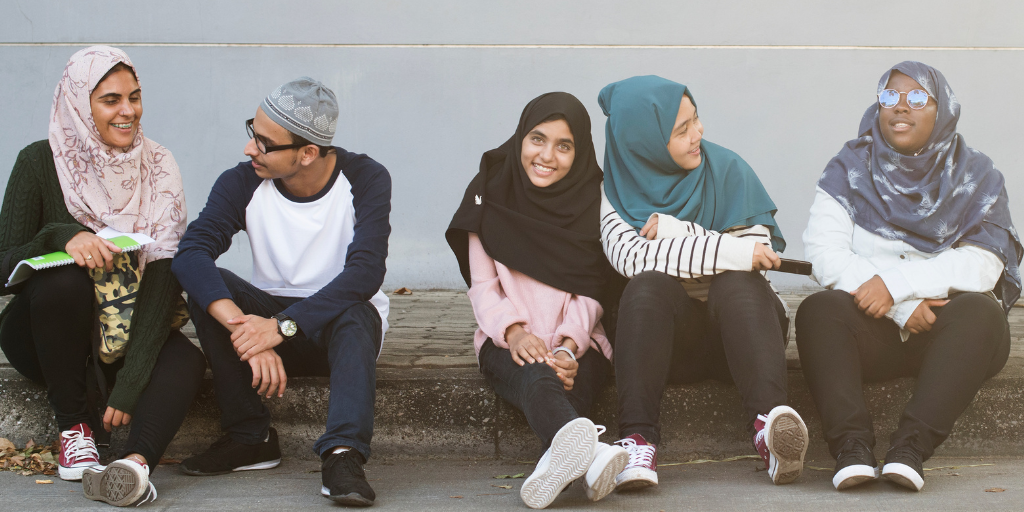
Results: Community
Topics covered by assets and needs in this section pertained to questions about the Muslim community in Illinois. This included questions about giving to Muslim organizations; mosque attendance; support for health and social services; inclusivity in mosque decision-making; and discrimination within and toward the Muslim community.
ASSET: Illinois Muslims Give Generously
Another asset found within the sample of Muslim respondents is a willingness to contribute to their community. Around four out of five Muslims have donated to an organization associated with their faith community in the last 12 months. This is compared with just half of the Illinois general public sample.
While roughly a third of both the Muslim sample and the Illinois general public sample contributed between $100 and $500 annually, the Muslim sample was more likely to give at the higher end of the spectrum. Roughly a quarter of the Muslim sample contributed between $1,000 and $5,000 annually compared to 16% of the Illinois general public sample.
ASSET: Frequent Mosque Attendance Is an Asset for Community Mobilization and Mental Health
Around 72% of the Muslim sample attended their mosque at least once a month prior to the pandemic. This has important ramifications for community building. Higher mosque attendance is linked with increased volunteering and higher civic engagement for the group.⁸ In addition, more frequent mosque attendance is linked to better mental health outcomes, such as lower sadness and anger.⁹ By way of comparison, around 47% of the Illinois general public sample attends a house of worship once a month.
ASSET: Muslim Community Reports Less Drug Use but Favors More Support for Addiction Care
Muslims report consuming significantly less alcohol than the Illinois general public. Of the Muslim sample, 95% stated they do not consume any alcohol as opposed to 48% of the Illinois general public sample. One-third of the Muslim sample indicated they know an individual within their faith community who has struggled with addiction, compared to 41% of individuals in the Illinois general public sample.
However, 75% of the Muslim respondents stated their faith community needs to do more work to support individuals with addictions. This is an important asset within the Muslim community as it shows a deep level of empathy for their fellow community members and presents an opportunity for organizations and leaders in this field to gain momentum. In contrast, 53% of the general public indicated their faith community should do more to support individuals struggling with addiction.
NEED: Greater Investment in Nontraditional Nonprofits
We found that while 80% of Muslims do donate to nonprofit organizations, just 3% donate to family and youth organizations or research organizations associated with their faith community while 9% give to “civic” or civil rights organizations. A lack of funding to these organizations may leave the community with less capacity to inform and advocate for their needs with policymakers. This points to a need within the Illinois Muslim community to invest in all such organizations.
Of those who donated to a faith-based community organization, 30% of Muslim respondents stated they had given to an overseas organization while around 28% of respondents said they had given to their house of worship. This compares to 15% of the general public who donated to an overseas relief organization and 41% who donated to their house of prayer.
While Muslim respondents were more likely than the general public in Illinois to support overseas relief, they were equally likely to support domestic relief organization (20% and 17%, respectively).
These results depart slightly from trends in the nation as a whole where Muslims were found to be as likely as other faith communities in the US to donate to overseas relief.
NEED: More Responsive Muslim Sacred Spaces
Among respondents who attended their house of prayer at least once a month, Muslim respondents were twice as likely as the Illinois general public to state that their opinion doesn’t matter in their house of prayer (28% of the Muslims sample vs. 14% of the Illinois general public sample). That being said, 72% of Muslim respondents said that their opinion does count in their house of prayer as did 86% of the Illinois general public respondents. This presents a need for mosque leadership to better engage those who attend their institution and find ways to better listen and address their needs.
There is little difference within the Muslim sample along gender lines with 26% of men and 30% of women stating their opinion doesn’t matter in their house of prayer. When examined more closely and looking specifically at the role of women in decision-making within the mosque, 25% of Muslim respondents stated they don’t believe that women are included in decision-making in their house of faith. This number is significantly higher than the Illinois general public sample, where 10% of respondents stated they don’t believe women are included in decision-making in their house of faith. Within the Muslim sample that responded to the question, 22% of men stated they believed women were not included in decision-making while 34% of women stated they believed they weren’t included in decision-making.
When examined along lines of race, 37% of Black Muslim respondents and 30% of both Arab Muslim respondents and Asian Muslim respondents agreed that their opinion does not count in their house of prayer while only 10% percent of white Muslims said the same. When looking across age demographics, almost 34% of Muslim respondents stated they believed young people were not included in decision-making in their house of prayer; this consisted of 37% of young adults aged 18-29, 30% of individuals aged 30-49, and 27% of individuals aged 50+. By contrast, 20% of the Illinois general public sample believed that young people are not included in decision-making in their house of prayer.
NEED: Gender Discrimination
The proportion of Muslim respondents in our sample that face gender discrimination outside their faith community is similar to the proportion of respondents that face gender discrimination inside their faith community. Among the Illinois Muslim sample, 28% stated they experience gender discrimination within their faith community and 34% of Muslim respondents stated they experience discrimination outside their faith community.
Not surprisingly, this issue affects Muslim women much more than it affects Muslim men. While 14% of Muslim men in our sample reported experiencing gender discrimination within their faith community, 47% of Muslim women in our sample reported experiencing discrimination within their faith community. When compared to gender discrimination faced outside the faith community, 23% of Muslim men in our sample said they face discrimination, as opposed to 49% of the Muslim women in our sample who said they face gender discrimination. So, in our sample, Muslim women were roughly as likely to report gender discrimination from outside their faith community as inside.
In comparison, 25% of women in the Illinois general public sample reported facing gender discrimination from within their faith community while 31% reported facing gender discrimination from outside their faith community.
NEED: Anti-Black Racial Discrimination Inside and Outside Muslim Community
Muslim respondents also reported facing more racial discrimination outside their faith community than inside. While 28% of Muslim respondents stated they experienced racial discrimination within their faith group, 51% of Muslim respondents stated they experienced racial discrimination outside their faith group. Within the faith community, Black Muslims face the most discrimination (51%), followed by Arab Muslims (28%), Asian Muslims (30%), and white Muslims (10%).
Outside the faith community, Black Muslims still face high levels of racial discrimination (59%), on par with Arab Muslims (59%) and Asian Muslims (58%). About one in five white Muslims (19%) report facing racial discrimination outside their faith community. This presents a clear need to address intra-Muslim racism, particularly anti-Black racism, as well as racism in wider society.


